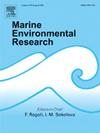Expanding sample volume for microscopical detection of nanoplastics
IF 3
3区 环境科学与生态学
Q2 ENVIRONMENTAL SCIENCES
引用次数: 0
Abstract
The extent of nanoplastic pollution has raised severe environmental and health concerns. While the means for microplastic detection are abundant, improved tools for nanoplastic detection are called-for. State-of-the-art microscopic techniques can detect nanoplastics down to tens of nanometers, however, only from small sample sizes (typically ). In this work, we describe a method that enables sampling of 1 l of seawater by the means of correlative Raman- and SEM-techniques. This is achieved by adapting common microplastic sample purification protocols to suit the nanoplastic study. In addition, we decorate a membrane filter with SERS-property to amplify the Raman signals. Together, the purification method combined with the use of the SERS-activated-membrane-filter enables identification and imaging of individual nanoplastic particles from significantly larger sample sizes than before. In the nanoscale the average recovery rate is 5 %. These results aim to provide useful tools for researchers in the fight against plastic pollution.
扩大纳米塑料显微检测的样品量。
纳米塑料污染的严重程度引起了人们对环境和健康的严重关注。虽然微塑料检测手段十分丰富,但纳米塑料检测工具仍有待改进。最先进的显微镜技术可以检测到数十纳米的纳米塑料,但只能从小样本量(通常为 ∼10μl)开始。在这项工作中,我们介绍了一种利用拉曼和扫描电镜相关技术对 1 升海水进行采样的方法。这是通过调整常见的微塑料样品纯化协议以适应纳米塑料研究而实现的。此外,我们还装饰了具有 SERS 性能的膜过滤器,以放大拉曼信号。这种纯化方法与 SERS 激活膜过滤器的使用相结合,可以从比以前大得多的样品中识别单个纳米塑料颗粒并对其进行成像。在纳米尺度上,平均回收率为 5%。这些成果旨在为研究人员提供有用的工具,以对抗塑料污染。
本文章由计算机程序翻译,如有差异,请以英文原文为准。
求助全文
约1分钟内获得全文
求助全文
来源期刊

Marine environmental research
环境科学-毒理学
CiteScore
5.90
自引率
3.00%
发文量
217
审稿时长
46 days
期刊介绍:
Marine Environmental Research publishes original research papers on chemical, physical, and biological interactions in the oceans and coastal waters. The journal serves as a forum for new information on biology, chemistry, and toxicology and syntheses that advance understanding of marine environmental processes.
Submission of multidisciplinary studies is encouraged. Studies that utilize experimental approaches to clarify the roles of anthropogenic and natural causes of changes in marine ecosystems are especially welcome, as are those studies that represent new developments of a theoretical or conceptual aspect of marine science. All papers published in this journal are reviewed by qualified peers prior to acceptance and publication. Examples of topics considered to be appropriate for the journal include, but are not limited to, the following:
– The extent, persistence, and consequences of change and the recovery from such change in natural marine systems
– The biochemical, physiological, and ecological consequences of contaminants to marine organisms and ecosystems
– The biogeochemistry of naturally occurring and anthropogenic substances
– Models that describe and predict the above processes
– Monitoring studies, to the extent that their results provide new information on functional processes
– Methodological papers describing improved quantitative techniques for the marine sciences.
 求助内容:
求助内容: 应助结果提醒方式:
应助结果提醒方式:


